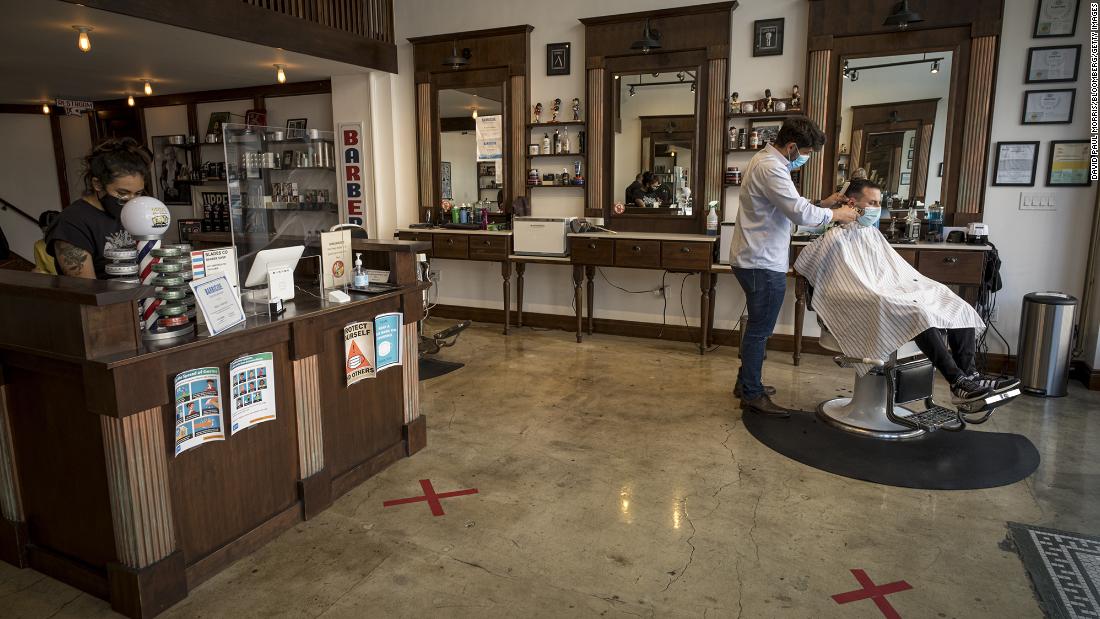
There's much to celebrate about Thursday's GDP report, which showed the US economy grew at a record annualized rate of 33.1% during the third quarter. It's evidence of the powerful one-two punch of fiscal stimulus and easy money from the Federal Reserve. And it reflects the reopening of much of the US economy.
Unfortunately, there are real obstacles going forward that will slow the recovery, perhaps severely. Some economists even fear the economy will begin shrinking again, setting off a double-dip recession.
Surging coronavirus infections will slow growth this fall and winter. Hotels, restaurants, movie theaters, airlines and other hard-hit businesses can't fully recover when the pandemic is worsening.
The failure of Congress and the Trump administration to reach a stimulus deal means more small businesses will surely fail, state and local layoffs may accelerate and no stimulus checks are coming to alleviate the pain for consumers anytime soon.
"Without further fiscal aid until 2021, a poorly managed health situation and election uncertainty could make for a long winter," Gregory Daco, chief US economist at Oxford Economics, wrote in a report Monday.
'Very shaky' outlook
Economists are bracing for the inevitable slowdown. Over the past six weeks, the New York Federal Reserve's GDP Nowcast model halved its estimate for annualized growth to just 3.5% during the fourth quarter. That would mark a sharp deceleration from the blockbuster summer GDP report.
Jefferies is even more pessimistic, projecting annualized growth of only 2% during the final three months of the year. That's because the premature withdrawal of fiscal stimulus will likely deal a blow to consumer spending -- the biggest driver of the economy and brightest spot of late.
"The outlook for Q4 is very shaky in our view," Aneta Markowska, chief financial economist at Jefferies, wrote in a report to clients Thursday. "The economy has already lost a lot of momentum over the summer."
The Back-to-Normal Index, created by CNN Business and Moody's Analytics, plunged below 60% in early April. It swiftly rebounded to about 80% by August. But it hasn't budged since.
Likewise, the CNN Business Economic Recovery tracker shows that hotel occupancy is still 31% below pre-crisis levels. US airports are processing fewer than half the travelers they did at this point of 2019.
Double-dip recession risk is real
And these trends could backtrack as states and cities attempt to fight the spread of the pandemic. Already, Chicago and Newark have announced new restrictions. Germany and France are implementing partial lockdowns. Disneyland Paris is shutting down again.
"The path forward will inevitably be an uphill struggle," Seemah Shah, chief strategist at Principal Global Investors, wrote in a report Thursday. "With virus cases on the rise and a new fiscal package yet to be seen, economic concerns are once again brimming to the surface."
That's why some economists believe the recovery will stall.
"We are sliding back into recession as we speak," Danielle DiMartino Booth, CEO and chief strategist of Quill Intelligence, told CNN Business this week.
Jeoff Hall, managing economist at Refinitiv IFR, warns there is a "strong possibility of negative growth" in the fourth quarter, perhaps even a double-digit decline in GDP, as COVID cases rise and new restrictions are imposed.
Even the housing market, arguably the hottest part of the economy, is showing signs of cooling off.
Pending home sales unexpectedly dropped in September, according to new numbers released Thursday. That marks the first decline since April and comes despite record low mortgage rates.
Ian Shepherdson, chief economist at Pantheon Macroeconomics, is more nervous about early 2021 than the end of this year.
"We're worried that the first quarter could see zero growth," Shepherdson wrote in a report, "unless new stimulus is passed almost immediately after the inauguration on January 20."
When will stimulus arrive?
That's why the outcome of the election will play a pivotal role in the recovery.
If Democrats sweep the election, Jefferies expects a massive $3.5 trillion fiscal stimulus plan. That would drive a stronger recovery, Jefferies said, with 2021 GDP increasing by 5.5%.
But the size of a fiscal stimulus package would be smaller, perhaps much smaller, if Democrats and Republicans split control of Congress and the White House. Such a scenario would cause GDP to grow more gradually, Jefferies said.
Whoever is in charge will take on an enormous challenge: The US economy is still down nearly 11 million jobs from before the pandemic. JPMorgan doesn't see a full jobs recovery until 2022.
"The easy part of the economic rebound is over," said Lauren Goodwin, economist at New York Life Investments.
"now" - Google News
October 30, 2020 at 12:32AM
https://ift.tt/31UYMwP
America just posted a record GDP growth rate. Now brace for the slowdown - CNN
"now" - Google News
https://ift.tt/35sfxPY
Bagikan Berita Ini














0 Response to "America just posted a record GDP growth rate. Now brace for the slowdown - CNN"
Post a Comment